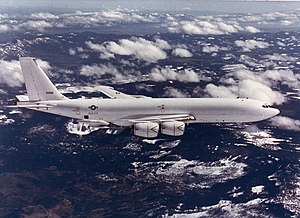Boeing E-6
| Boeing E-6 Mercury | |
|---|---|
 E-6A "Mercury I" of the US Navy |
|
| Type: | Command aircraft |
| Design country: | |
| Manufacturer: | |
| First flight: |
February 1987 |
| Commissioning: |
August 1989 |
| Number of pieces: |
16 |
The Boeing E-6 , also E-6 TACAMO ( Take Charge and Move Out ) or E-6 Mercury , is an aircraft type of the US Navy based on the Boeing 707 and serves as a combat control platform, especially for the transmission of status messages of the strategic and US Navy tactical submarines .
history
In the Cold War , a connection to the nuclear submarines in the vastness of the oceans was important. For this purpose, the US Navy used converted Lockheed C-130 "Hercules" machines from the mid-1960s . At the beginning of the 1980s these reached the end of their lifespan, so that a successor was sought and in 1982 the US Navy issued a tender. After long negotiations, on April 29, 1983, Boeing finally received a development order for the E-6A based on the Boeing 707-320B.
The design adopted large parts of the Boeing E-3A AWACS , including the CFM56 turbofan engine . The rollout of the first copy of the machine, initially called Hermes , took place in Renton in December 1986, the first flight (actually a transfer flight for equipment and tests at Boeing Field in Seattle) on February 19, 1987. There were problems with the during testing Vertical stabilizer and the wing sheeting, which were caused by the loads when towing the antennas. The first E-6A were not put into service until August 2, 1989 in Barbers Point, Hawaii.
A total of 16 copies of this type were delivered between 1989 and 1992. From 1995, twelve machines were equipped with additional communication systems so that they could take over communication with land-based ICBMs. These machines were now called E-6B Mercury II and took over the looking-glass operations of the decommissioned USAF EC-135C from October 1, 1998 . For this purpose, the MILSTAR and other electrical equipment were removed from the EC-135C and installed in the E-6. The first of these machines was ready in May 1997, started on June 25, 1997 for testing at Patuxent River and declared operational in October 1998.
By the end of 2003, all E-6A had been converted to the B version. You can recognize the converted machines by the "hump" on the front fuselage, which houses the MILSTAR equipment and antennas. In the course of time, the machines were further modernized. From 2002, they received a modern glass cockpit and, following a corresponding order in 2004, they received modern radio systems from Rockwell Collins . The first of these machines converted to the Block-I standard went back to the US Navy on February 24, 2009. The E-6 are expected to remain in service until 2030.
Technical specifications
The main features of the E-6 are two towed antennas of 1200 and 7925 meters in length in the long wave range for communication with submarines. The longer of the two antennas has to hang almost vertically for transmission, which is achieved by flying in tight circles at speeds of around 250 to 340 km / h and bank angles of 30 to 50 °. The E-6B has three VHF / UHF, five HF and UHF Satcom and an ALR-66 (V) 4 EloKa system installed.
| Parameter | Data |
|---|---|
| template | Flying command post and radio relay aircraft |
| crew | 22 (19 on the E-6A4, 4 of them in the cockpit and 7-15 operators in the cabin) |
| drive | 4 × CFM International CFM56-2A-2 (referred to as F108-CF-100) |
| length | 46.61 m |
| span | 45.16 m |
| height | 12.93 m |
| Wing area | 283.4 m² |
| Gauge | 6.73 m |
| wheelbase | 17.98 m |
| front cargo door | 2.34 x 3.40 m |
| fuel | 70,305 kg |
| Empty weight | 78,380 kg |
| Takeoff weight | 155,130 kg |
| Marching speed | 842 km / h |
| Top speed | 981 km / h |
| Service ceiling | 12,800 m |
| Patrol Height | 7,620 - 9,150 m |
| Mission range without aerial refueling | 11,760 km |
| Duration of use | 15h 24min |
| Unit price | $ 140 million |
See also
- Looking Glass (Airborne Command Center)
- TACAMO communication system
Web links
- Boeing E-6 on Boeing's Web site (English).
Individual evidence
- ↑ FlugRevue, July 2009, pp. 49–52, aircraft down to the smallest detail - Boeing E-6 Mercury
